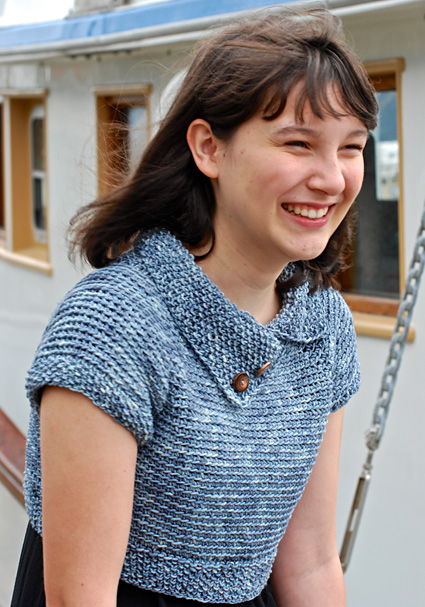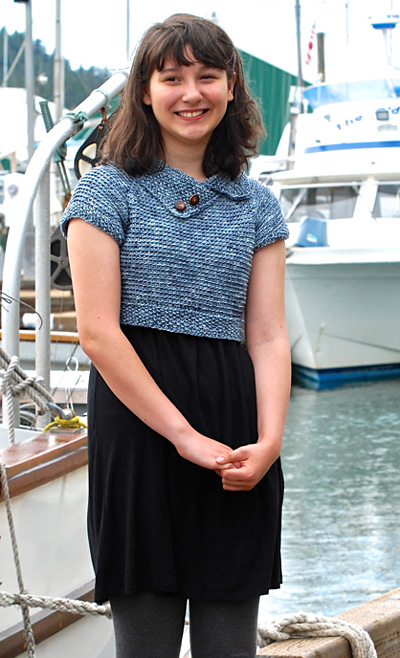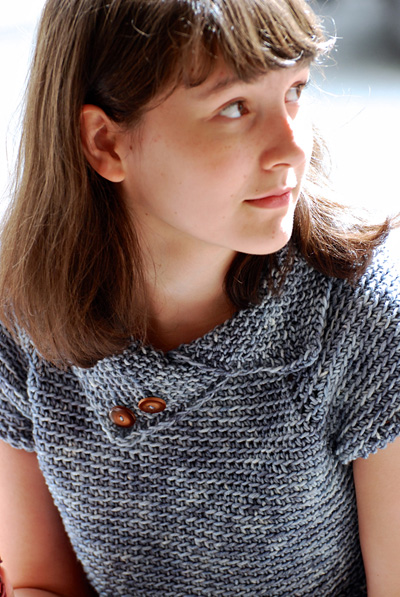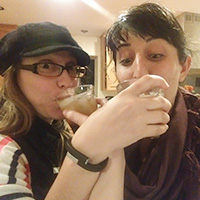

|
All You Need Is Gauge A lot of bi-craftual makers -- people who both knit and crochet -- find that they have very different tensions between the two crafts. These differences can be especially pronounced if you knit with the yarn in your right hand (aka English or Throwing Method) and Crochet with the yarn in your left. Trying to find a stitch gauge that pairs your knitting and crochet takes experimenting and a willingness to play a little before jumping into a pattern. Swink! is a little different because you begin with a crochet gauge swatch that you measure yourself --you don't need to match a pattern gauge; you just keep track of a gauge you are comfortable with. Swatch, measure; then wash, block, and measure again. Fill in the worksheet (which provides a custom fit!). When you start to knit, you'll pick up knitting stitches along the edge. If your knitted edge doesn't ruffle or pull too tight, you're good to go. If not, then you can change your knitting needle size accordingly. Getting Started To create a foundation single crochet:
These images will help you visualize the difference:
|
|||||||||||
 by Amy O'Neill Houck This pattern is in worksheet format—that means there's no guessing about what size to make or how your Swink! will fit. Making Swink! just requires the same things you need for any garment—a swatch, and your measurements. After that, we walk you step-by-step through a few easy calculations that make this pattern zoom along and fit great. There are a few things you don't have to worry about with Swink!: you'll never count rows, and you don't have to keep track of which size or measurements to follow because this pattern was written JUST FOR YOU. |
|||||||||||
|
|
|||||||||||
|
SIZE |
|
TAKING MEASUREMENTS Cross Back (Shoulder to Shoulder): ____________ [CB] High Bust (circumference just under the arms – this is typically above the fullest part of the bust): ___________ [HB] Length (Measure from your collar bone to the bottom of your rib cage): _______ Calculate your Neckline using your Cross Back measurement: |
|
MATERIALS Notions |
|
GAUGE |
Make your crocheted swatch in the round: Measure your swatch before blocking: __________ [UBG](sts per 4 inches) Block swatch, lay flat to dry, then take gauge: ____________ [BG](sts per 4 inches) ____________ [SPI] (divide by 4 for sts per inch) Knitted stitch gauge for the collar and bottom edge should match the crochet stitch gauge. Pick up stitches along the last edge of the crocheted swatch with needles the same size as your hook and work back and forth (in rows) in seed stitch. If your work lays flat without pulling or ruffling, you've found a good match. If your knitting is tighter than your crochet, go up a needle size. If it's much looser, try a smaller needle. Calculate Increase Width (I): Divide Blocked Gauge by Unblocked Gauge: Multiply High Bust by [D]: Add in Ease: Gauge of Swink! shown: A note about gauge: This pattern plays with gauge by pairing a large hook/generous gauge with a springy-twisty heavy worsted yarn. The result is a fabric that has both drape and a lot of stretch. If you choose a different kind of yarn, you don't have to match the pattern gauge, but you do need to accurately measure your gauge to make the calculations work. |
|
PATTERN NOTES |
|
sc-blo: single crochet in the back loop The collar and edging are knitted in seed stitch with a slipstitch edge. Seed Stitch (Worked back and forth over an even number of sts): Seed Stitch (Worked back and forth over an odd number of stitches): The cuffs are knitted in seed stitch in the round. Seed Stitch in the Round (Over an even number of stitches): Seed Stitch in the Round (Over an odd number of stitches): |
|
DIRECTIONS 
Calculate your Foundation (fsc): Step 1: Neckline Measurement x [SPI] : ___________________ Step 2: Adjust result from Step 1 to nearest multiple of 6: __________ (R) (HINT: Here's a handy list of multiples of 6: 54, 60, 66, 72, 78, 84, 90, 96, 102, 108, 114) Then add 4 stitches: _______ (fsc) For example: If my cross-back measurement were 14, I would have a neckline measurement of 20.16 inches. Multiplied by my crochet gauge = 63 sts. 60 is the closest number divisible by six, so my foundation chain would 60 +4 = 64 sts. Calculate your marker placement: Neckline Place Markers Sleeve Shaping Repeat increase round until front section measures to your calculation (I) from the worksheet above, and the sleeve section wraps comfortably around your arm when you try on the sweater.  Form Sleeve Caps Lower Body Cowl Neck (KNITTING) Do not join. Work back and forth in seed stitch until the cowl portion measures 5 inches. Bind off in pattern. Bottom Edging Count your body stitches: _____________ sts With wrong side of front facing, join yarn in front of right-hand coil-less safety pin. Using circular needle, pick up the back loop only across to next safety pin. Cuffs |

|
|
FINISHING |
| ABOUT THE DESIGNER |
 Amy and Miriam both have patterns on ravelry.com. |
| Pattern & images © 2015 Amy O'Neill Houck + Miriam Felton. Contact Miriam |